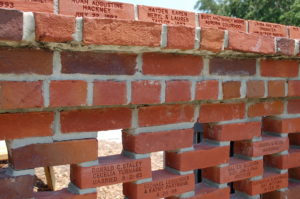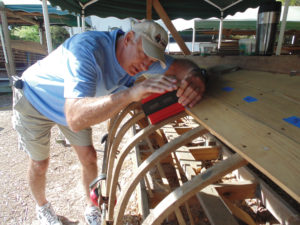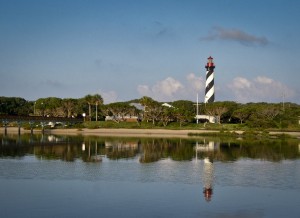This ninth and final installment in our series on the history of the St. Augustine Lighthouse focuses on the recent history of the lighthouse and the creation of the
St. Augustine Lighthouse & Museum.
Click the links below to read previous posts in the series:
- Lighthouse History Pre-1874
- Lighthouse History 1874-1894 (Part I)
- Lighthouse History 1874-1894 (Part II)
- Lighthouse History 1894-1914
- Lighthouse History 1914-1934
- Lighthouse History 1934-1954
- Lighthouse History 1954-1974
- Lighthouse History 1974-1994
1994 – 2014
The lighthouse has been opened to the public since 1994, thanks to the tireless efforts of the Junior Service League of St. Augustine. From the beginning, it has been a popular destination for the local community and the many visitors our city attracts each year. So popular in fact, the Junior Service League (JSL) quickly recognized that daily operations required funding and upgrades.
In 1996, the JSL began a fundraiser to pave the walkway from Keepers’ House to the lighthouse and to rebuild the brick wall that historically ran the perimeter of the light station. For a donation, visitors could purchase a brick in the walkway or the wall and engrave it with a personal message. This campaign provided the necessary funds for the site upgrades. It was so successful that the program is still running and new brick areas are now available behind the Keepers’ House and in the courtyard.
In 1998, the JSL created The St. Augustine Lighthouse & Museum, Inc. (SAL&M), a 501(c)3 non-profit organization, to handle operations of the light station as a historic site and museum. SAL&M began interpreting the site through exhibits in the Keepers’ House and with staff members and volunteers sharing the stories of the lighthouse and its keepers. In those early years of the organization, all operations, including staff offices and the gift shop were in the Keepers’ House along with the exhibits.
Maritime Archaeology
In 1999, the organization decided to expand its focus beyond the light station into the waters off the coast. The Lighthouse Archaeological Maritime Program (LAMP) is one of the few research units in the nation pursuing professional maritime archaeology that is not guided or funded by a university or governmental entity.
From 2007-2009, LAMP secured state grant funding for the First Coast Maritime Archaeology Project (FCMAP) that helped expand their scope from St. Johns County to the entire “First Coast” region of Northeast Florida. Although funding for the FCMAP ended in 2009, the remote sensing surveys from the project are still guiding our archaeologists to new and exciting discoveries of this area’s maritime history and heritage. In 2010, LAMP began working on a site identified by the FCMAP survey that has yielded artifacts from the Revolutionary War era.
LAMP also established a Heritage Boatworks at the lighthouse in 2007. Staffed entirely by volunteers, the Boatworks has built several wooden boats and is committed to keeping this maritime tradition alive and relevant by constructing living replicas of vessels once common in the waters of St. Augustine and northeast Florida. The boat builders’ work also helps our archaeologists with the interpretation, reconstruction and experimental replication of archaeological boat and ship remains.
Boatworks at the lighthouse in 2007. Staffed entirely by volunteers, the Boatworks has built several wooden boats and is committed to keeping this maritime tradition alive and relevant by constructing living replicas of vessels once common in the waters of St. Augustine and northeast Florida. The boat builders’ work also helps our archaeologists with the interpretation, reconstruction and experimental replication of archaeological boat and ship remains.
The National Historic Lighthouse Preservation Act of 2000
Technological improvements in the 20th century made the role of lighthouses in maritime safety redundant. GPS, radar and sonar systems, and modern mapping replaced the beacons that for so long illuminated our coastline. As such, the U.S. government began looking for a way to offload the financial and logistical responsibility of keeping the country’s lighthouses operational while ensuring their continued survival.
To address this issue, Congress passed the National Historic Lighthouse Preservation Act (NHLPA) in 2000 as an extension of the National Historic Preservation Act of 1966. The NHLPA established “a national historic lighthouse preservation program” to ensure the continued operation and maintenance of U.S. lighthouses by entities other than the federal government.
According to the NHLPA, an entity eligible to take over operations of a historic lighthouse “shall make the historic light station available for education, park, recreation, cultural or historic preservation purposes for the general public at reasonable times and under reasonable conditions.”
In 2002, the St. Augustine Lighthouse became property of The St. Augustine Lighthouse & Museum organization under the auspices of the NHLPA. Meeting the requirements of the NHLPA also means keeping the lighthouse operational as a private, working aid-to-navigation.
The St. Augustine Lighthouse & Museum
The mission of the St. Augustine Lighthouse & Museum is “to discover, preserve, present, and keep alive the stories of the Nation’s Oldest Port, as symbolized by our working lighthouse.” This includes preservation and maintenance of our historic structures, which includes the lighthouse and Keepers’ House as well as smaller buildings on site like the World War II Coast Guard Barracks and Garage.
The museum has created and hosted exhibits on a variety of subjects including the lives of the keepers and their families, lighthouse lenses, and maritime archaeology. Museum staff members have served as advisors for other organizations who own and operate private aids-to-navigation. Maritime archaeologists have recovered the region’s maritime history and heritage from the ocean floor so we can all better understand and appreciate it. And each night the light continues to shine bright, letting all who see it know that they are near St. Augustine.
exhibits on a variety of subjects including the lives of the keepers and their families, lighthouse lenses, and maritime archaeology. Museum staff members have served as advisors for other organizations who own and operate private aids-to-navigation. Maritime archaeologists have recovered the region’s maritime history and heritage from the ocean floor so we can all better understand and appreciate it. And each night the light continues to shine bright, letting all who see it know that they are near St. Augustine.
Visit our website to learn about all we do here at the lighthouse. You can keep up on the latest lighthouse happenings at on Facebook, Twitter, and Instagram.
Paul Zielinski is Director of Interpretation for the St. Augustine Lighthouse & Museum. He received his master’s degree in Public History from the University of West Florida and joined the lighthouse family in 2011.

